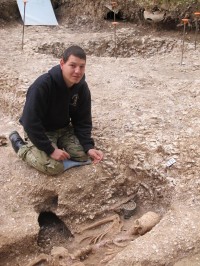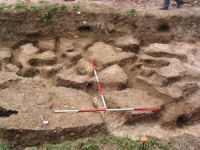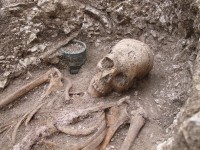 Rifleman Rowan Kendrick of the 5th Battalion, The Rifles (a British Army infantry regiment) has unearthed the remains of an Anglo-Saxon warrior buried about 1500 years ago on Salisbury Plain. Kendrick is a volunteer with Operation Nightingale, a project that places injured veterans on archaeological sites as a form of physical and social therapy and to help them develop new occupational skills. He and a team of more than 100 Riflemen injured in Afghanistan have been excavating the Anglo-Saxon cemetery at Barrow Clump under the direction of Ministry of Defence archaeologist Richard Osgood, supervised by professional archaeologists from Wessex Archaeology and together with students from the University of Leicester.
Rifleman Rowan Kendrick of the 5th Battalion, The Rifles (a British Army infantry regiment) has unearthed the remains of an Anglo-Saxon warrior buried about 1500 years ago on Salisbury Plain. Kendrick is a volunteer with Operation Nightingale, a project that places injured veterans on archaeological sites as a form of physical and social therapy and to help them develop new occupational skills. He and a team of more than 100 Riflemen injured in Afghanistan have been excavating the Anglo-Saxon cemetery at Barrow Clump under the direction of Ministry of Defence archaeologist Richard Osgood, supervised by professional archaeologists from Wessex Archaeology and together with students from the University of Leicester.
The Barrow Clump site is one of approximately 20 barrows in an earthwork near Stonehenge that was in use from the Neolithic period until the Norman invasion. The Anglo-Saxons made a cemetery of a Bronze Age burial ground on the spot. Multiple graves have been discovered since the first ones were unearthed in the late 19th century by archaeologist and former Lieutenant-Colonel in the British Army William Hawley (who would go on to make major discoveries at Stonehenge after it was gifted to the state in 1919).
 The barrows are under attack. From badgers. They dig extensive tunnel systems, plowing through Anglo-Saxon graves, jumbling the archaeological layers and destroying bones and artifacts. In 2003, English Heritage did a survey and excavation of the site to assess the badger damage and find ways to prevent it going forward. By 2011, broken pieces of pottery and human remains appearing on the surface made it clear that those preventative measures were not working. English Heritage added the barrow to its Heritage at Risk list and advised that the Anglo-Saxon cemetery should be fully excavated, the cemetery’s perimeters determined, and its artifacts and human remains removed since they can no longer be preserved in situ. No badgers will be harmed in the making of this history.
The barrows are under attack. From badgers. They dig extensive tunnel systems, plowing through Anglo-Saxon graves, jumbling the archaeological layers and destroying bones and artifacts. In 2003, English Heritage did a survey and excavation of the site to assess the badger damage and find ways to prevent it going forward. By 2011, broken pieces of pottery and human remains appearing on the surface made it clear that those preventative measures were not working. English Heritage added the barrow to its Heritage at Risk list and advised that the Anglo-Saxon cemetery should be fully excavated, the cemetery’s perimeters determined, and its artifacts and human remains removed since they can no longer be preserved in situ. No badgers will be harmed in the making of this history.
This summer Wessex Archaeology, funded by the British military, began a three-year project to excavate Barrow Clump. It’s a pilot for future Operation Nightingale endeavors and so far it’s going swimmingly. The first digging season the team has focused on excavating later Anglo-Saxon burials. Rifleman Kendrick’s discovery of an early Anglo-Saxon burial was an unexpected delight. Also unexpected was the remarkably well-preserved wood tankard bound with bronze strips. The wood is still intact. A spear head was found above the tankard marking the deceased as a warrior. Unfortunately, he’s missing his right forearm. Judging from the large burrow opening where his arm once was, it was a victim of badgerial interference.
 All told, the Operation Nightingale team has discovered 27 Anglo-Saxon burials this season, from warriors to women to children, complete with varied grave goods like jewelry, a shield boss and that bronze-bound wooden tankard. They expected to find around 15 graves since the burial ground is fairly small, so from an archaeological standpoint the project has been a raging success.
All told, the Operation Nightingale team has discovered 27 Anglo-Saxon burials this season, from warriors to women to children, complete with varied grave goods like jewelry, a shield boss and that bronze-bound wooden tankard. They expected to find around 15 graves since the burial ground is fairly small, so from an archaeological standpoint the project has been a raging success.
The project’s rehabilitative goals have also been achieved with gusto. The riflemen have learned to parlay some of their military skills (surveying, mapping, examining ground features for anomalies that could be IEDs or Anglo-Saxon graves, hard manual labor, living in tents in crappy weather) into a highly rewarding civilian pursuit. Eight of the soldiers are now studying archaeology at the University of Leicester. For now only the five regular battalions of the Rifles, Britain’s largest infantry regiment, have participated in Operation Nightingale. The hope is that the program will eventually expand to cover the entire Army.
Once conserved and cleaned, the artifacts will go on display at the Wiltshire Heritage Museum. For more about the discoveries at Barrow Clump and Operation Nightingale, follow the blog on the Wessex Archaeology website.